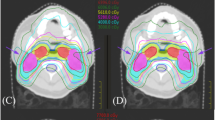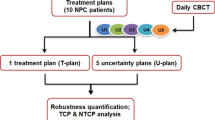Abstract
Objective
This study aimed to evaluate the quality of locally advanced nasopharyngeal carcinoma (NPC) radiotherapy plans generated by the automated planning module of a commercial treatment planning system (TPS).
Methods
Data of 30 patients with locally advanced NPC were retrospectively investigated. For each patient, volumetric modulated arc therapy (VMAT) plans with double arcs were generated manually by experienced physicists and automatically in the Pinnacle3 Auto-Planning module (Philips Medical Systems, Fitchburg, WI, USA). The anatomic distance between the second clinical target volume (CTV2) and the pons of the brainstem, and the T category of disease were factored into the evaluation. Dosimetric verification was evaluated in terms of gamma pass rate. Target coverage, sparing of organs at risk (OARs), and monitor units were evaluated and compared between the manual and automatic VMAT plans.
Results
Not all treatment plans fully met the dose objectives for planning target volumes (PTVs) and OARs, particularly in T4 patients. Overall, automatic VMAT provides a comparable or superior plan quality to manual VMAT in most cases. In stratified analysis, plan quality is mainly independent on T category but is also affected by anatomic distance. If the anatomic distance is less than 5 mm, the automatic VMAT plan quality is equal or even inferior to manual VMAT performed by experienced physicists. Conversely, if the anatomic distance is greater than 5 mm, the automatic VMAT plan quality is superior to manual VMAT. Gamma pass rates for quality assurance are similar between manual and automatic VMAT plans for the former case, but significantly higher in automatic VMAT for the latter.
Conclusion
The selection of manual versus automatic VMAT planning in locally advanced NPC should be made individually based on the anatomic distance, rather than blindly and habitually, since automatic VMAT is not good enough to completely replace manual VMAT.



Similar content being viewed by others
References
Lu SH, Cheng JH, Kuo SH, Lee JS, Chen LH, Wu JK et al (2012) Volumetric modulated arc therapy for nasopharyngeal carcinoma: a dosimetric comparison with TomoTherapy and step-and-shoot IMRT. Radiother Oncol 104(3):324–330
Sun Y, Guo R, Yin WJ, Tang LL, Yu XL, Chen M et al (2013) Which T category of nasopharyngeal carcinoma may benefit most from volumetric modulated arc therapy compared with step and shoot intensity modulated radiation therapy. Plos One 8(9):e75304
Verbakel WF, Cuijpers JP, Hoffmans D, Bieker M, Slotman BJ, Senan S (2009) Volumetric intensity-modulated arc therapy vs. conventional IMRT in head-and-neck cancer: a comparative planning and dosimetric study. Int J Radiat Oncol Biol Phys 74(1):252–259
Kam MK, Teo PM, Chau RM, Cheung KY, Choi PH, Kwan WH et al (2004) Treatment of nasopharyngeal carcinoma with intensity-modulated radiotherapy: the Hong Kong experience. Int J Radiat Oncol Biol Phys 60(5):1440–1450
Lee TF, Chao PJ, Ting HM, Lo SH, Wang YW, Tuan CC et al (2011) Comparative analysis of SmartArc-based dual arc volumetric-modulated arc radiotherapy (VMAT) versus intensity-modulated radiotherapy (IMRT) for nasopharyngeal carcinoma. J Appl Clin Med Phys 12(4):158–174
Ning ZH, Mu JM, Jin JX, Li XD, Li QL, Gu WD et al (2013) Single arc volumetric-modulated arc therapy is sufficient for nasopharyngeal carcinoma: a dosimetric comparison with dual arc VMAT and dynamic MLC and step-and-shoot intensity-modulated radiotherapy. Radiat Oncol 8(1):237
Tol JP, Delaney AR, Dahele M, Slotman BJ, Verbakel WF (2015) Evaluation of a knowledge-based planning solution for head and neck cancer. Int J Radiat Oncol Biol Phys 91(3):612–620
Song Y, Wang Q, Jiang X, Zhang Y, Bai S (2016) Fully automatic volumetric modulated arc therapy plan generation for rectal cancer. Radiother Oncol 119(3):531–536
Wang J, Chen Z, Li W, Qian W, Wang X, Hu W (2018) A new strategy for volumetric-modulated arc therapy planning using AutoPlanning based multicriteria optimization for nasopharyngeal carcinoma. Radiat Oncol 13(1):94
Speer S, Klein A, Kober L, Weiss A, Yohannes I, Bert C (2017) Automation of radiation treatment planning. Strahlenther Onkol 193(8):656–665
Zhang Q, Peng Y, Song X, Yu H, Wang L, Zhang S (2020) Dosimetric evaluation of automatic and manual plans for early nasopharyngeal carcinoma to radiotherapy. Med Dosim 45(1):e13–e20
Krayenbuehl J, Norton I, Studer G, Guckenberger M (2015) Evaluation of an automated knowledge based treatment planning system for head and neck. Radiat Oncol 10(1):226
Fogliata A, Belosi F, Clivio A, Navarria P, Nicolini G, Scorsetti M et al (2014) On the pre-clinical validation of a commercial model-based optimisation engine: application to volumetric modulated arc therapy for patients with lung or prostate cancer. Radiother Oncol 113(3):385–391
Hussein M, South CP, Barry MA, Adams EJ, Jordan TJ, Stewart AJ et al (2016) Clinical validation and benchmarking of knowledge-based IMRT and VMAT treatment planning in pelvic anatomy. Radiother Oncol 120(3):473–479
Hansen CR, Nielsen M, Bertelsen AS, Hazell I, Holtved E, Zukauskaite R et al (2017) Automatic treatment planning facilitates fast generation of high-quality treatment plans for esophageal cancer. Acta Oncol 56(11):1495–1500
Delaney AR, Dahele M, Tol JP, Slotman BJ, Verbakel WF (2017) Knowledge-based planning for stereotactic radiotherapy of peripheral early-stage lung cancer. Acta Oncol 56(3):490–495
Wang J, Hu W, Yang Z, Chen X, Wu Z, Yu X et al (2017) Is it possible for knowledge-based planning to improve intensity modulated radiation therapy plan quality for planners with different planning experiences in left-sided breast cancer patients? Radiat Oncol 12(1):85
Ferris MJ, Zhong J, Switchenko JM, Higgins KA, Cassidy RJ III, McDonald MW et al (2018) Brainstem dose is associated with patient-reported acute fatigue in head and neck cancer radiation therapy. Radiother Oncol 126(1):100–106
Kamal M, Rosenthal DI, Batra A, Volpea S, Elgohari B, Goepfert RP et al (2019) Fatigue following radiation therapy in nasopharyngeal cancer survivors: a dosimetric analysis incorporating patient report and observer rating. Radiother Oncol 133:35–42
Paddick I (2000) A simple scoring ratio to index the conformity of radiosurgical treatment plans. Technical note. J Neurosurg 93(Suppl 3):219–222
Kataria T, Sharma K, Subramani V, Karrthick KP, Bisht SS (2012) Homogeneity Index: an objective tool for assessment of conformal radiation treatments. J Med Phys 37(4):207–213
Bohsung J, Gillis S, Arrans R, Bakai A, De Wagter C, Knöös T et al (2005) IMRT treatment planning—a comparative inter-system and inter-centre planning exercise of the ESTRO QUASIMODO group. Radiother Oncol 76(3):354–361
Ouyang Z, Shen ZL, Murray E, Kolar M, LaHurd D, Yu N et al (2019) Evaluation of auto-planning in IMRT and VMAT for head and neck cancer. J Appl Clin Med Phys 20(7):39–47
Nawa K, Haga A, Nomoto A, Sarmiento RA, Shiraishi K, Yamashita H et al (2017) Evaluation of a commercial automatic treatment planning system for prostate cancers. Med Dosim 42(3):203–209
Gintz D, Latifi K, Caudell J, Nelms B, Zhang G, Moros E et al (2016) Initial evaluation of automated treatment planning software. J Appl Clin Med Phys 17(3):331–346
Teoh M, Clark CH, Wood K, Whitaker S, Nisbet A (2011) Volumetric modulated arc therapy: a review of current literature and clinical use in practice. Br J Radiol 84(1007):967–996
Marrazzo L, Meattini I, Arilli C, Calusi S, Casati M, Talamonti C et al (2019) Auto-planning for VMAT accelerated partial breast irradiation. Radiother Oncol 132:85–92
McNiven AL, Sharpe MB, Purdie TG (2010) A new metric for assessing IMRT modulation complexity and plan deliverability. Med Phys 37(2):505–515
LoSasso T, Chui CS, Ling CC (1998) Physical and dosimetric aspects of a multileaf collimation system used in the dynamic mode for implementing intensity modulated radiotherapy. Med Phys 25(10):1919–1927
Masi L, Doro R, Favuzza V, Cipressi S, Livi L (2013) Impact of plan parameters on the dosimetric accuracy of volumetric modulated arc therapy. Med Phys 40(7):71718
Craft D, Süss P, Bortfeld T (2007) The tradeoff between treatment plan quality and required number of monitor units in intensity-modulated radiotherapy. Int J Radiat Oncol Biol Phys 67(5):1596–1605
Creemers IH, Kusters JM, van Kollenburg PG, Bouwmans LC, Schinagl DA, Bussink J (2019) Comparison of dose metrics between automated and manual radiotherapy planning for advanced stage non-small cell lung cancer with volumetric modulated arc therapy. Phys Imag Radiat Oncol 9:92–96
Funding
This work was supported financially by Guangzhou Key Medical Discipline Construction Project Fund, Technology Project of Guangzhou Medical and Health Science (Grant Number: 20181A011095).
Author information
Authors and Affiliations
Contributions
All authors participated in patient treatment and were involved in preparation of the manuscript. Q.Z., L.O., and S.Z. were responsible for the primary concept and design of the study; Y.P. and H.Y. planned and performed the experiments; Q.Z. and L.W. performed the data capture and analysis; Q.Z. and L.O. drafted and wrote the manuscript. All authors reviewed and approved the final manuscript. L.O. and S.Z. share corresponding authorship.
Corresponding authors
Ethics declarations
Conflict of interest
Q. Zhang, L. Ou, Y. Peng, H. Yu, L. Wang, and S. Zhang declare that they have no competing interests.
Ethical standards
All experimental protocols of this study were approved by the Institutional Review Board of the Affiliated Cancer Hospital and Institute of Guangzhou Medical University. All patients included into this study had given their approval to use their data for scientific research. All personal information to identify patients was removed from the image data and analyzed retrospectively.
Caption Electronic Supplementary Material
Rights and permissions
About this article
Cite this article
Zhang, Q., Ou, L., Peng, Y. et al. Evaluation of automatic VMAT plans in locally advanced nasopharyngeal carcinoma. Strahlenther Onkol 197, 177–187 (2021). https://doi.org/10.1007/s00066-020-01631-x
Received:
Accepted:
Published:
Issue Date:
DOI: https://doi.org/10.1007/s00066-020-01631-x




